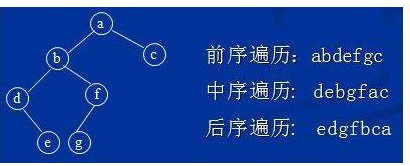concept:
The traversal naming is named
according to the location where the access node operation occurs:
① NLR: Preorder Traversal (also known as Preorder Traversal)
-The operation of visiting the root node occurs before traversing its left and right subtrees.
② LNR: Inorder Traversal
——The operation of visiting the root node occurs in (between) traversing the left and right subtrees.
③ LRN: Postorder Traversal
-The operation of visiting the root node occurs after traversing its left and right subtrees.
Common feature: In the three traversal methods, the order of the leaf nodes is the same from left to right.
For example:
Reminder: You can understand the traversal sequence according to the code, and then walk through this picture yourself.

Traversal algorithm:
1. Preorder traversal
The definition of the recursive algorithm of first (root, previous) order traversal:
If the binary tree is not empty, perform the following operations in sequence:
(1) Visit the root node;
(2) Traverse the left subtree;
(3) Traverse the right subtree.
Pre-order traversal of python code:
class Solution:
def preorderTraversal(self, root: TreeNode) -> List[int]:
def forward(root1):
if not root1:
return
ans.append(root1.val)
forward(root1.left)
forward(root1.right)
ans = []
forward(root)
return ans
2. In-order traversal
The definition of recursive algorithm for middle (root) order traversal:
If the binary tree is not empty, perform the following operations in sequence:
(1) Traverse the left subtree;
(2) Visit the root node;
(3) Traverse the right subtree.
In order to traverse the python code:
class Solution:
def inorderTraversal(self, root: TreeNode) -> List[int]:
def middle(root1):
if not root1:
return
middle(root1.left)
ans.append(root1.val)
middle(root1.right)
ans = []
middle(root)
return ans
3. Post-order traversal
The definition of the recursive algorithm after (root) order traversal:
If the binary tree is not empty, perform the following operations in sequence:
(1) Traverse the left subtree;
(2) Traverse the right subtree;
(3) Visit the root node.
Traverse the python code in post-order:
class Solution:
def postorderTraversal(self, root: TreeNode) -> List[int]:
def backward(root1):
if not root1:
return
backward(root1.left)
backward(root1.right)
ans.append(root1.val)
ans = []
backward(root)
return ans
4. Use the front and middle traversal sequence to reconstruct the binary tree
Idea : The first element of the pre-order traversal must be the root node, and then by finding the position of the middle-order root node in the middle-order traversal, the distribution of the left and right leaves can be judged (in the middle-order traversal, the left leaves of the root node are all left leaves , All right leaves behind).
# Definition for a binary tree node.
# class TreeNode:
# def __init__(self, val=0, left=None, right=None):
# self.val = val
# self.left = left
# self.right = right
class Solution:
def buildTree(self, preorder: List[int], inorder: List[int]) -> TreeNode:
if len(preorder)==0:
return
root = TreeNode(preorder[0]) # 根节点肯定是前序遍历的第一个
root_index = inorder.index(preorder[0]) # 返回中序遍历中根节点的位置,该位置之前全是左叶子,之后全是右叶子。注意前序和中序遍历序列中,左右叶子的长度肯定相同
root.left = self.buildTree(preorder[1:root_index+1], inorder[:root_index])
root.right = self.buildTree(preorder[root_index+1:], inorder[root_index+1:])
return root
5. Reconstruct the binary tree using the middle and post traversal sequence
Idea : The last element of the post-order traversal must be the root node, and then by finding the position of the middle-order root node in the middle-order traversal, the distribution of the left and right leaves can be judged (in the middle-order traversal, the left leaves of the root node are all left. All right leaves behind). Finally, the distribution of post-order traversal is judged according to the length of the left and right leaves in the middle order (in post-order traversal, all the left leaves are distributed to the left, and all the right leaves are all on the right)
# Definition for a binary tree node.
# class TreeNode:
# def __init__(self, val=0, left=None, right=None):
# self.val = val
# self.left = left
# self.right = right
class Solution:
def buildTree(self, inorder: List[int], postorder: List[int]) -> TreeNode:
if not postorder:
return None
root = TreeNode(postorder[-1]) # 后序最后一个节点是根节点
n = inorder.index(root.val) # 取出中序中根节点的index,可以快速判别左右子树
root.left = self.buildTree(inorder[:n], postorder[:n]) # 在中序中,根节点的左子树元素都在左边;在后序中,根节点的右子树元素也都在左边
root.right = self.buildTree(inorder[n+1:], postorder[n:-1]) # 在中序中,根节点的右子树元素都在右边;在后序中,也都在左边,但是就不取最后一个元素了,因为最后一个是根
return root
Note: It is not possible to reconstruct a unique binary tree using the front and back traversal sequence